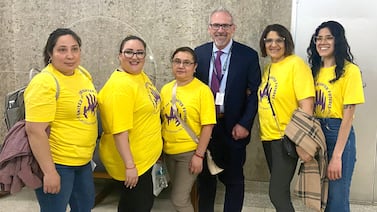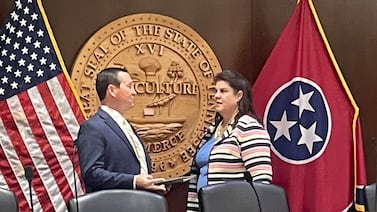Read our voting guide covering all candidates here.
The transcript has been lightly edited for clarity.
Christina Veiga (0:00)
Okay, so thank you again, for agreeing to do this, I know that you care a lot about early childhood issues. So this should all be right up your alley. So first off, I want to start with like a big picture at the federal level, there seems to be a lot more attention to Pre-K, and Early Care, and access and affordability. And there seems to be a lot more resources that are coming with that. And so I’d love to hear from you how you would prioritize that. What parts of the system, you would, for example, strengthen which parts you would build out?
“Unprecedented federal funding is on the way. High-poverty schools are starting to reckon with how to spend it.” by Matt Barnum and Kalyn Belsha
Eric Adams (0:33)
When you look at education, number one, the question we should be asking now that were receiving this large contribution coming from the federal level to look at education. We must go at the root, and look at the historical inequities. And it’s really mind boggling to me, and sort of personally hurtful, when I talk about early childhood education. You know, for many years, I have experienced learning disabilities, and it wasn’t until I got into college, that I started to just drill down on it and then later in life as, actually the borough president. When I looked at our poor definition of early childhood development, we think is from K to 12. And the neurologists and pediatricians are clear. It’s the first 1,000 days of life, and that life is not when the baby’s born, that life is in a mother’s womb. That’s the first classroom. It’s all about nutrition. It’s about support. It’s about ensuring that she’s receiving the information about brain development. And we just don’t do that in poorer communities. So now it’s an opportunity to do just the opposite to use these funds in closing the achievement gap, not K through 12, but pregnancy through profession. And if we don’t do that, we’re setting children on a pathway of really having irreversible learning disabilities, and won’t give them the opportunity to really be productive citizens. I see this over and over again, if you don’t educate, you will incarcerate, and that’s reflected in the incarceration rates, you see, at even Rikers Island with 80% of the men and women that are incarcerated don’t have a high school diploma or equivalency diploma.
Christina Veiga (2:23)
So I want to turn to affordability, and access. The city has definitely made strides expanding Pre-K, but affordable infant and toddler care can still be really hard to access, and really expensive. There’s a backlog of families waiting to receive vouchers to help pay for care. And at the same time providers say that they have seats in their centers that are going empty. So what is your understanding of where the problem lies there? And how would you solve it?
Eric Adams (2:52)
Well it lies, the problems we’re seeing, about putting our babies, and our children, in the seat for healthcare, for childcare, I think it lies in two areas. Number one, information. Number two, the failure to make it affordable and build out the spaces. So this is a great opportunity. As I mentioned, in my UCARE, my universal childcare program, we need to prioritize space in city owned buildings, because that is one of the largest cost, to having infant care and toddler care, is the cost of the space. We can utilize office spaces in city buildings. We can rethink the number of employees who are returning to work. there’s a there’s a large number of employees that could now do their work remotely. We need to be bold enough to move in that direction. And then we need to look at those private owned businesses, and buildings, and give a density bonus to residential building owners, who are willing to bring down give, permanently free, or low rent to providers, by giving them a tax break in the process in private owned businesses. And lastly, we can look at our leases. I strongly believe, based on the analysis of my team, we can save almost $250 million if we look at the leases, of that, we are, you know really, in contract with throughout the entire city. We are a paying a premium price for expensive luxury locations, when we can build this in the outer borough have our office spaces, build that out our outer borough, become anchor tenants to build up communities around, and that money that we save can go into really ensuring we have a universal infant, toddler care, and childcare at the same time.
Christina Veiga (4:58)
So when it comes to specifically to the voucher issue, you think it’s an education issue and that?
Eric Adams (5:04)
Yes, yes, I do. And when I say educational issue, it is communicated in the language, and in the cultures, that people receive information. We do a poor job in communicating in the diverse languages such as Chinese and Urdu. All these different languages of our city. Our failure to communicate in the multiple languages in the city is causing us to leave too much on the table. When it comes down to resources, we need to really re-empower the Census teams. These teams were made up of a coalition of nonprofit organizations and groups, who communicated on the ground, to their various ethnic and cultural groups. We should be using these teams year round to continually push out information. And there’s no information that’s more important to push out than information about access to childcare, access to infant, and toddler care. We don’t do a good enough job in doing that.
Christina Veiga (6:13)
Something else that a lot of working families struggle with is care for after the school day is over. And that is in Pre-K and child care as well as after school care and that sort of thing. So do you and providers say, especially at the Pre-K level, that more extended day, and extended school year slots are needed? I know you have thoughts about how long the school year should be. But do you think especially in Pre-K that there should be universal access to extended school day and school year care?
Eric Adams (6:47)
You know, I’m a big believer in utilizing our school buildings, and other spaces, to have extended care, childcare, even for our students that are in high school, middle school, elementary school. And that’s why I introduced as the borough president, something called the extended use program. Think about this for a moment. 7 a.m. we tell our babies, “welcome to school.” 3 p.m. we say, “get out and don’t come back until tomorrow.” These buildings, they lay empty from 3 p.m. to 7 a.m. the next day. That is unacceptable. My extended use plan opened the school buildings, we allocated $2 million. And we opened the school buildings to allow nonprofit local community based organizations (CBOs) to use this space for free. Because when you really think about the cost, rental of space, use of space, that is really some of the largest parts of actually having an overhead. So we were successful in doing so. I think we need to continue to expand this citywide. To allow our schools to be used, not only for educational experiences, but also soft skills, communication, critical thinking, operating groups, dealing with diversity, leaning into educational experience by appreciating the diversity of our city. That’s how we get to the roots of hate crime. And financial literacy, all of these skills that our children need to continue the development of their brains, and to learn those soft skills for the future. And we can do it by opening our schools. We have to properly manage our assets. I think we’re doing a terrible job in doing so. And it’s right in front of us.
Christina Veiga (8:53)
I want to turn to the workforce in early education. There have been strides in achieving something closer to pay parity for those teachers who are in childcare centers and Pre-K centers in New York City, but there’s still a lot of room to go. Pre-K, Special Education teachers, have largely been left out of the equation and there is not a plan yet to catch up teachers who have been teaching in Community Based Organizations (CBOs) for a long time. So, do you have a plan for reaching salary parity? And if so, what is your timeline in which you’d like to see that done?
“Does Biden’s plan for a $15 minimum wage for child care workers go far enough?” by Ann Schimke, Cassie Walker Burke, and Koby Levin
Eric Adams (9:27)
I believe salary parity is crucial for these early childhood educators. You know, there’s a level of hypocrisy when we talk about how important it is for our children to have that early start in life. And I think part of the problem is, we believe and we don’t really respect, the power of those early days. It’s planting a seed. If that seed is not planted in the right soil, then it would actually not turn into the full plant that it should turn into. And nothing is more important than that seed’s development, of those who are responsible for shaping the brain in the minds of our children. And so I’m going to clearly invest in professional development for a new generation of early childhood educators, and a study from the best up-to-date brain science research, we spend a lot of time looking at what children learn, and not how they learn. And I clearly support the calls, especially from experts like Bank Street College, in their pursuit of a living wage as part of its shift toward pay and benefits parity. It is almost humiliating what we are paying of these professionals. And so we have to move in a level of increasing compensation through increasing educational, and credential attainment. So let’s incentivize receiving more credentials, more experience, so that we will get the true benefit of these early childhood years. We focus too much and believe it’s only about K through 12. That is just not true. The research is clear, we now have to build our system around the research, and not build it around what we have always done in the past. Because that is going to continue to produce the failing product that we are seeing day to day, year after year, of graduation after graduation.
Christina Veiga (11:34)
Do you have a timeframe in which you think salary parity would be attainable? And all these additional, you know, additional professional development (PD), all of that, what’s the timeframe?
Eric Adams (11:45)
What we should clearly, when we look at the timeframe of reaching pay parity, building out the infrastructure, nothing is more exciting than now. Because that we were able to receive the monies from a long, hard fought battle, of campaign for fiscal equity. The mayor is going to receive a substantial amount of money coming from the state as well as the monies we’re going to receive from the federal government. So, this is the opportunity to deal with the upfront costs that’s associated with it. And once we deal with the upfront costs, we can ensure in the outer years, that we will continue to just stabilize what we’re doing now. So I believe in the first one and two years, there should be a clear stepped process of assuring pay equity that we’re looking for. And a reinvestment in early childhood development. Because as I stated, I used the term intentionally: investment. Because Archbishop Desmond Tutu states, “we spent a lifetime pulling people out of the river, no one goes upstream, and prevent them from falling in in the first place.” If we don’t go upstream, and invest in our children, we’re going to pay a higher cost in pulling them out of the river. The lack of education, the lack of employment, the lack of mental health services, downstream. So it’s an investment to go upstream. And it’s a good investment for that upfront cost, before we put our children on a pathway of not being a productive citizen, for individuals who need this society to carry them through.
Christina Veiga (13:31)
I want to shift gears a little bit to after school programming and summer programming, which are also crucial for working families. But providers say that every year they’re caught in a “budget dance” where they have to advocate for the budget to do these things. And so would you commit to ending that? Which programs would you like to see, if any, funded on a longer term basis?
“NYC official: Funding for summer jobs program expected to increase, following year of steep cuts?” by Reema Amin
Eric Adams (13:56)
Summer program and an after school program, to me, they both go together. The goal is to really eradicate the summer slide. We seem to ignore that, because the summer slide for the most part impacts, Black and brown immigrant communities. When you go to affluent communities, the entire summer, and even after school, there are clear programs that are laid out, where the children are experiencing everything from the museums, to cultural institutions. You don’t see that in poorer communities, and immigrant communities, and so I’m focused on the summer slide. I’ve stated more than once. We need to use the synner months to expand summer school options. I believe we need to have a universal tutorial program that’s in place where children and families can come together to get the tutorial services that they need. And I also believe we need to use the summer months to really help parents become more knowledgeable, on how they help their children throughout the school year. So I think that our schools must stay open year round, and available for day long activities, and so many different ways, not only to our students, who we’re focusing on in early learning, but also our continuing education of children in the latter years as well. It needs to be a real support system during the summer months. We underutilize our schools during the summer months. And we must be sure that we stop making it too difficult for our local community based organizations (CBOs). To do that jobs because we are delaying payments, making it too challenging to receive your payments, and jumping through too many hoops, to get the resources you need to focus on our children. I’m going to have a person at City Hall, that will be a clear liaison between our community based organizations (CBOs) and all of our agencies to make sure that we can expedite and ensure that payments are on time net 30 or net 60 to ensure that our community based organizations (CBOs) can do the job that we need them to do without worrying about reimbursements.
Christina Veiga (16:19)
So is that a yes to ending the so called budget dance?
Eric Adams (16:24)
That is a two thumbs up, yes.
Christina Veiga (16:30)
I want to zoom out now, looking ahead to the next school year, and reopening. The next mayor will will be in charge sort of halfway through the next school year, but in your perfect world. In the meantime, what do you think the city needs to be doing now to build trust with families so that they return? We’ve seen, especially in Pre-K, major dips in enrollment down about 13% this year. And we’ve seen that families of color have been among the most reluctant to go back. So how do you turn that tide?
“No remote learning option for NYC next school year, de Blasio announces” by Amy Zimmer and Alex Zimmerman
Eric Adams (17:02)
It is so important that we turn the tide to the low enrollments that we’ve seen, and just the lack of trust, and I call it the three C’s: clarity, consistency, and communication. And we need to start that build out over the summer months. You don’t wait until a week, two weeks, before school starts, and then start informing parents of exactly what’s taking place. Let’s build out a real robust communication system using everything from texting, to phone calls, to robo calls, to local stakeholders, to websites that would give clear information on what to expect, and up-to-date information. And then let’s use our local, I like to call them credible messengers. And to really get the information out to all of the diverse groups in the city. And I use this over and over again, the lack of communicating to people in the manner in which they receive information, and the language they receive information is one of the biggest inhibitors of for our entire city to get things done. And so we must have a robust communication network to ensure that our parents receive the clarity, the consistency, and the proper communication throughout the year. And we need to make sure we have strict compliance with robust testing in place. Strict compliance with face mask, and social distancing. Now that the CDC stated three feet is a safe distance, we need to comply with that to make sure that we don’t have another spike in in COVID. And lastly, we need to really invest in a robust, complete overhaul of the remote learning program. Not using it as a foundation to learning, but to compensate for our children to help supplement the current learning system. We didn’t do it this time. There’s an art to remote learning, not only for the students, but also for the educators. So we need to show that we will have one of the best remote learning systems in this entire country.







